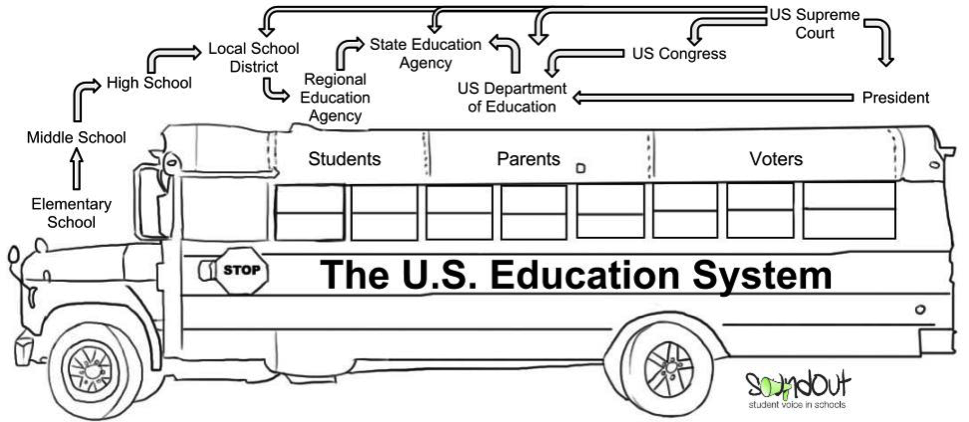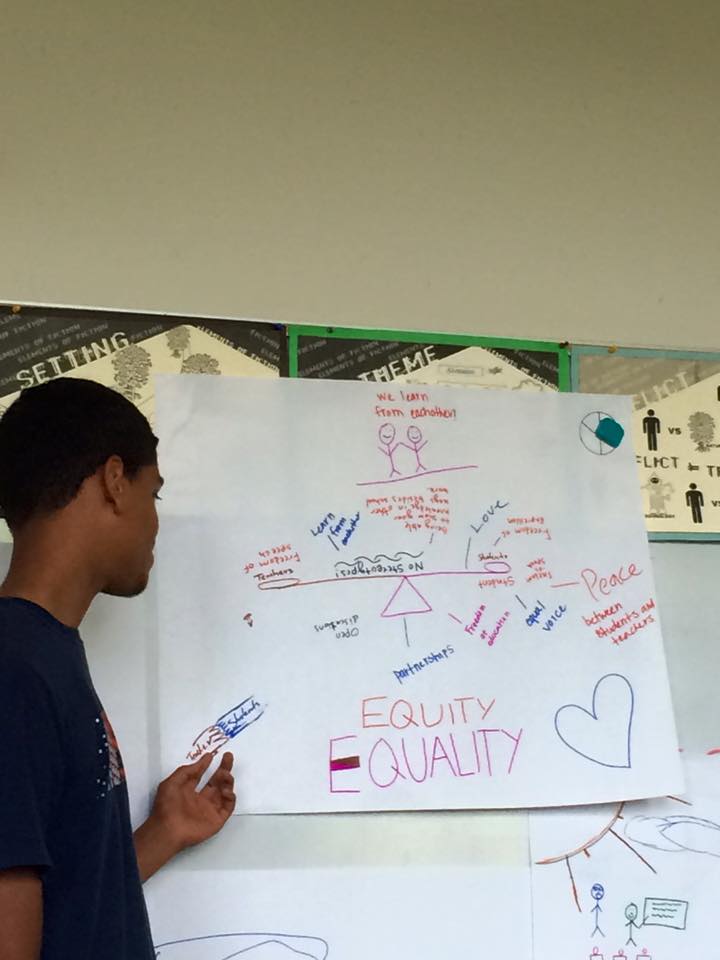Getting clear on who is involved in schools is not easy. We need to understand how decisions are made in schools. In order to affect schools, you can build your understanding of how decision-making in schools works.
The following positions represent as the typical “flow” of decision-making affecting students in public schools. Different people may exert different kinds of influence in every decision. Each person is not guaranteed a place “at the table” (most here often are excluded). Following is a summary of everyone who might be involved.
Each of these roles can include student voice; few currently involve students in meaningful ways. Following are descriptions of each role, and how Meaningful Student Involvement can happen with them.
Roles That Make Decisions In Schools

Students
—All students everywhere, in every grade and every school, should experience Meaningful Student Involvement every day. Individual students determine whether they’re meaningfully involved. You are in ultimately in charge of your own education because you can actively choose whether or not you are going to actively participate and learn in schools.
Peers
—Younger and older students actively and passively influence other students’ decision-making. This can be meaningful if its done intentionally to make schools better.
Student Leaders
—Many schools have active programs that draw out “traditional student leaders” by identifying certain skills or abilities students have. Despite having a range of abilities, these student leaders are mostly focused on activities that affect students only. However, a growing number of student leaders have an increasing amount of ability toaffect the whole education system. There are also “nontraditional” student leaders whose influence over their peers’ decision-making has not been acknowledged in school.
Parents
—Guiding children is one of the most important jobs of parents; this is especially true in schools. Parents can also passively or actively decision-making.
School Support Staff/Paraprofessionals/Adult Volunteers
—Secretaries, adult tutors, coaches, librarians, classroom assistants, and parent representatives may influence student decision-making. Paraprofessionals are people who are hired to work in schools to help students and teachers be successful.
Teachers
—Everyday students are subjected to a range of decisions made by teachers about grading, curriculum, behavior management, and relationships with students. Teachers are also responsible for executing others’ decisions.
Teacher Leaders
—Among the faculty at a school are teachers whose experience, knowledge, or influence gives them ability, authority, or position to make decisions for other teachers. These teachers may lead grade-level or curriculum areas, participate on special committees, or influence decision-making in other ways.
Counselors
—Students often go to counselors to ask questions, seek advice, and talk to when they need a supportive adult in school. While they often guide student decision-making with classes or life after high school, counselors may also help students make decisions about life in general.
Assistant Principal
—Many schools principals need assistants to guide behavior management, budgeting, staff supervision, curriculum, and other areas. They affect students by doling out punishments and rewards; guiding student activities; and in other ways.
Principal/HeadMaster
—The commonly acknowledged “leader” of a school is responsible for most areas of school operations, including many of the assistant principal roles listed above. They also publicly represent the school; mediate conflicts among students, staff, parents, and community members; and interact with district, state, and federal authorities.
District Administration
—Officials on the district level administer programs, funds, rules and regulations given to them by their superiors. In some states districts are simply counties (Maryland) or large regions. New York City has more than 10 districts. District offices may also be known as a local education agency, or LEA.
District Superintendent
—The leader of a given area or group of schools, superintendents are often the first elected official in the chain of decision-making affecting students. Sometimes they are appointed by the district school board or city mayor. They act as the figurehead and authority of all education-related issues within their physical area of authority.
District School Board
—These elected officials get recommendations from the public and the superintendent to deliver their range of decision-making authority. They set the budget and agenda of schools, assign students to schools, make rules and policies, set learning standards, and more.
Regional Administration
—These are in-between organizations that may offer professional development, administrative guidance, or funding to districts and local schools. These offices have different names, including Educational Service Districts (Washington); BOCEs (New York); or Regional Service Centers (Texas).
State Administration
—These officials are responsible for administering federal and state programs designed to meet the goals of schools. Also known as the state education agency or department of education. In several states this is the Office of Superintendent of Public Administration.
State Education Leader
—The state education leader may be elected or appointed; they may also work equally with the state school board and governor, or independently. They are responsible for guiding the implementation of the rules, regulations, laws, budgets, and programs of the state legislature; in some states, the governor; and the federal government. This person may be called the Chief Education Officer, or the Superintendent of Public Instruction (SPI).
State School Board
—An elected group of officials that overseas all schools and ensures the state’s adherence to federal rules and regulations. Students can be meaningfully involved as full voting members elected by their peers are responsible for a full slate of activities, issues, and outcomes.
Governor/State Legislature/State Supreme Court
—The state-level officials who are responsible for setting state priorities and funding for education, as well as ensuring local, state, and federal compliance with education laws.
U.S. Secretary of Education
—The individual official responsible for setting and implementing the President’s education agenda. The leader of the U.S. Department of Education.
U.S. Department of Education
—The federal agency responsible for administering the budgets, rules, and regulations of the Secretary of Education and the Congress.
U.S. Representatives and U.S. Senators
—Elected officials responsible for setting the President’s educational policy recommendations into motion, in addition to supplementing their states’ policy with additional funding.
U.S. Supreme Court Justices
—These individuals are appointed to make sure schools comply with the Constitution and Bill of Rights.
U.S. President
—The elected official responsible for setting national educational priorities affecting all public schools.
Understanding Possibilities
These are the people who are currently affected by student voice, and who should be partners through Meaningful Student Involvement. Essentially they are all potential partners to transform education. They could serve as barriers to Meaningful Student Involvement. But ultimately, they are all simply people who are trying to do jobs they either volunteered for, were hired for, or were appointed or elected to. This is different from students, who are compelled to attend schools because of the law. There is a middle ground between each of these decision-makers and students though, and that’s what Meaningful Student Involvement reveals.
What do you think? Share your comments below!
For more information or assistance, contact us.
You Might Like…

